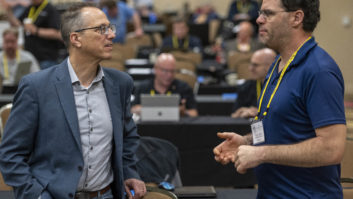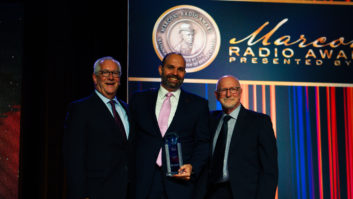Public radio and television broadcasters and public media producers have begun an effort to develop a seamless interface to share and distribute online and mobile content. The proposed digital distribution network is called the Public Media Platform.
Planners say demand for digital content is increasing as radio and TV stations launch additional interactive platforms and add enhanced content to their websites. PMP, they hope, will give stations and producers a low-cost means to distribute their online content; it also will serve as a technology backbone to enable systems that are now incompatible to connect and allow for access and flow of content.

Program producers and distributors American Public Media, NPR, Public Radio International and PBS are spearheading this effort. Public Radio Exchange, public media’s digital network allowing stations to share files for over-the-air broadcasting, is part of the group. The Corporation for Public Broadcasting is providing about $800,000 for the first six-month development stage. The six partners, which announced the plan in June, together kicked in another $200,000.
“The point is to create an infrastructure to allow all public broadcasters to create websites to meet their audience’s needs,” said Kinsey Wilson, senior vice president and general manager for NPR Digital Media.
“This will be a way for public media to share content, like audio, text, photos and video, across digital platforms in the digital space.”
PMP is based on public broadcasting’s Application Programming Interface that simplifies the task of sharing and combining content, Wilson explained. Stations would be able to direct content into PMP from their existing content management systems and retrieve content via API over Internet connections. Stations will have access to published protocols that allow computer programmers to connect one system to another easily.

This website is produced by KQED Interactive, the station’s third media platform, delivering content acquired and produced specifically for the Web. ‘Huge’ potential
“This is not a brand-new idea. We’ve talked about similar things in the past,” Wilson said.
“However, the level of interest from our broadcast partners is new. The level of attention radio and TV stations are paying to their digital space has grown tremendously. The potential is huge.”
PMP is not designed to serve a station’s distribution needs of over-the-air broadcast materials, planners said. The Public Radio Satellite System and its content management program, ContentDepot, will still serve as public radio’s content management and distribution system, just as the Next-Generation Interconnection System will continue to be used in the public TV arena.
NPR, which is managing the grant money, has been searching for ways to connect producers and public stations to share online content. Wilson said that chore was made more difficult without a common interconnection system.
“Broadcasters are making investments in digital media. The challenge has been to pull information off one system and load it to another. People build websites with different code that limits compatibility. Content winds up being locked up in individual systems,” Wilson said.
“PMP creates that interface to allow public media to combine their content in a shared platform and make it more widely available.”
Tim Olson, vice president digital media and education at KQED public radio and TV in San Francisco, said PMP will give individual broadcast stations the ability to deliver more diverse media content to websites and listeners’ mobile devices.
“Just as satellite infrastructure allows us to share broadcast content, [PMP] is for the Internet age. We will be able to pull content from PMP and present it on KQED Interactive,” Olson said.
KQED Interactive develops content and applications for digital platforms and mobile devices. It hosts online polls, podcasts, blogs and other items of interest, functioning as KQED’s third media platform — delivering content specifically acquired and produced for the Web.
“This will provide us a robust system to share material online,” Olson said. “We view digital and new media as a parallel to our air. We envision presenting a mix of local and national content seamlessly via the website. It will also allow us to upload locally produced content for other public media to share.”
PMP Advisory Council DocumentCloud
Dow Lohnes
Global Voices
iTVs
KPBS
KQED
Louisville Public Media
Mashery
Miro
National Black Programming Consortium
North Country Public Radio
PRSS
Publish2
Station Resource Group
Tow Center for Digital Journalism
WGBH
Source: NPRGetting a wider audience
Public media producers like “Prairie Home Companion” distributor American Public Media see PMP as a means to leverage their content to a wider audience, said spokesman Bill Gray.
“PMP will allow us to further our mission to expand perspectives and engage communities across the country through our programming,” he said. It will likely result in some cost savings for participants, but more importantly serve as a tool to fuel broader access to public broadcasting content, he said.
“As we invest in digital media we need figure out how to drive more audience engagement with our websites and interactive outlets. PMP will be the bus that drives the content,” Gray added.
Jason Seiken, senior vice president of interactive, product development and innovation for PBS, said, “The idea is to link various new media publishing systems across public radio and television stations.”
PBS already has a video platform that allows 156 local PBS stations to integrate national video with local video on station websites, said Seiken. PMP extends the concept. “PMP will integrate radio and TV public broadcasters and give them a low-cost way to share online content.”
The PMP leadership team, consisting of the six founding partners plus an advisory council, will focus this year on three specific pieces.
“We will have to work through the business rules regarding sharing of content,” Wilson said. The leadership team must evaluate costs and scale of the system. “We also want a very tangible prototype capable of showing what PMP is capable of. It will be a public demonstration, so that anyone from CPB to stations to the general public can observe results in action. It will provide CPB with a more detailed look at the mechanics of the system ‘under the hood.’”
Wilson described a multi-year process. “Rather than building it end-to-end and launch it, we want to build it incrementally. This will likely be a two- to three-year undertaking. Realistically, we will have some aspect of PMP up and running in the first year.”
He expects PMP to help foster innovation spurring others to approach developers with ideas for mobile apps.
“The availability of API [Application Programming Interface] is what caused Google to come to us and develop an Android app.” Android is Google’s operating system for mobile devices. “We hope to encourage more of this. We now have a road map in place for computer programmers and others to easily write code to easily pull information from our digital platform — a public protocol if you will.”












